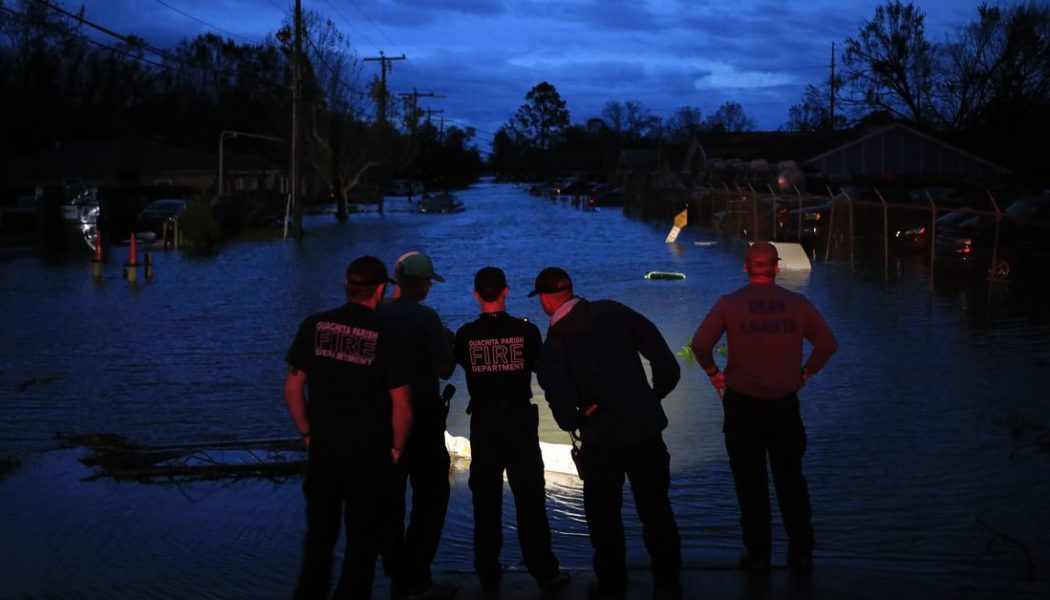
With less time to act as climate change churns up more rapidly intensifying storms like Hurricane Ida, coastal communities might have to rethink how they prepare for future storms. They could be forced to make tough decisions before a threat even fully materializes. Or they might take cues from how cities prepare for other types of disasters.
Ida grew monstrous overnight. In less than a day, its wind speed jumped from 85 to 150 miles per hour, making it the fifth strongest storm to land in the mainland US. After Ida pummeled Louisiana for hours over the weekend, “virtually no one” had electricity in the state Monday morning, Gov. John Bel Edwards said in a video posted to Twitter. Some places are under boil water advisories with water treatment systems out of commission. “We have tremendous damage to homes and businesses, we know that individuals are out there waiting to be rescued,” Edwards said.
Ida’s rapid intensification outpaced authorities’ abilities to get everyone in the storm’s path out of the way. And shape-shifting storms like Ida make it more difficult for forecasters and officials to convey just how much risk residents face.
“Rapid intensification is a nightmare, maybe the worst nightmare for emergency management and local state and federal government, because you don’t have a lot of time to prepare and it’s a moving target,” says John Knox, undergraduate coordinator of the Atmospheric Sciences Program at the University of Georgia.
New Orleans, which suffered a near-direct hit from Ida, only ordered mandatory evacuations of parts of the city outside of its protective levee system. Many residents hunkered down and braced for the impact of the hurricane. There wasn’t enough time to organize contraflow from the heart of the city, turning traffic so that it only heads out of New Orleans, officials said.
It might take 72 hours to evacuate the city before a hurricane makes landfall, according to one estimated timeline the city posted online. Ida strengthened from a depression to a tropical storm on August 26th, just about three days before it made landfall in Louisiana as a Category 4 storm.
“It takes longer to evacuate a city than it takes to build a destructive hurricane,” Kelly Hereid, director of catastrophe research & development at Liberty Mutual Insurance, tweeted yesterday. She points to lessons that could be learned from tsunami response when she says there might be only 10 to 30 minutes of warning in advance. In that scenario, some cities plan for “vertical evacuation.” Instead of leaving the area, people find shelter in structures built to withstand the catastrophe, she writes.
“Maybe planning large-scale emergency shelters to safely stay in place is part of the answer. Maybe it’s not,” Hereid writes. “But I know the answer is not: hope that *this time* we’ll have enough time to get everyone out.”
Still, knowing that New Orleans was in the path of the storm was fair warning for officials, according to James Marshall Shepherd, director of the Atmospheric Sciences Program at the University of Georgia. How much power a storm will pack is still hard to assess because it requires peering into the inner mechanics of a storm, but forecasting where a storm will hit has gotten incredibly precise, thanks to better computer models.
“I feel that there was time for public officials to do some more aggressive evacuations and to get people out of harm’s way,” Shepherd says, and it’s been “gut-wrenching” for him to watch the storm and its aftermath unfold. People just might need to be prepared for storms to pack a heavier punch than a simple category rating might suggest, he said. (Hurricanes are sorted into categories based on wind speed, with 1 being the lowest and 5 the highest. Categories don’t take into account other dangers like rainfall or storm surge.)
“A lot of people go to bed saying, ‘A Category 2 or Category 3 storm, I can kind of deal with that.’ And then they wake up to a Category 4, borderline Category 5 storm,” says Shepherd. Some people might not respond as urgently to a storm with a lower category rating than they would for one with a higher rating, Shepherd says, even though there’s still “danger inherent in both scenarios.” Officials might consider lowering the bar for cities to act, Shepherd wrote in Forbes today.
While Ida strengthened faster than other storms, the way it picked up steam was “textbook,” according to Knox. “For me and for my friends who are meteorologists, we all had a sense of dread because it seemed inevitable that it was going to rapidly intensify,” Knox said. They watched as warm waters in the Gulf of Mexico supercharged the storm, which feeds off heat energy. At the same time, there was a lack of wind shear to knock the growing hurricane down.
While that’s a familiar pattern, climate change speeds up the timeline and makes storms more intense as it raises ocean temperatures. Disaster planners might need to act more preemptively if future storms continue to outpace existing response plans.
“You have to get people to act before it’s actually in existence, almost,” says Knox. “To mobilize the public in particular about something that doesn’t even exist yet — because [Ida] wasn’t a monster, until the morning of when it hit — that’s the really hard part,” he says.
There were other complicating factors in New Orleans this time around. COVID-19 added a layer of risk to mobilizing people en masse, and the city’s hospitals struggled to find beds in other parts of the state for their patients.
There are also losses — measured in both lives and dollars — each time a community is forced to evacuate, which can, at times, take a bigger toll than the weather if the storm fizzles out. Evacuations for Hurricane Rita in 2005, for example, led to 100 of at least 119 deaths linked to the storm. Luckily, since forecasters have gotten much better at predicting where a storm will pass, there’s less risk of panicking people unnecessarily, according to Knox. But with storm intensity still somewhat of a wildcard and the peak of this year’s hurricane season still ahead, city leaders will have more hard decisions to face.









